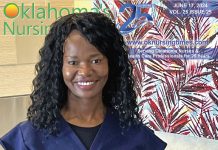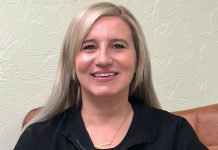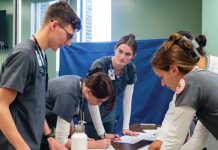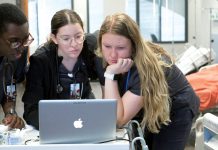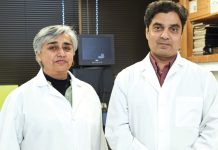
Story and photo by James Coburn, Staff Writer
The greatest gift Tambi Urias has as a licensed practical nurse is her anticipation of what’s coming next for her patients, she said.
“I like talking to them and hearing from them, everybody wants to tell me what’s going on,” said Urias, an LPN for Dr. Patrick Lo at the Oklahoma City Indian Clinic.
These patients need to be heard, she explained. It can be hard for some patients to talk about their pains or ask for assistance.
“You have to dig a little deeper to actually see what their needs are,” she said.
She has always had an affinity with Native Americans, their history and culture. Asian born, she lives in El Reno and is among a lot of Cheyenne and Arapaho tribes.
“We have a lot of homeless patients that ride the bus to come see us. Just recently we had a diabetic patient who was living in a homeless shelter, and the food that they get in the shelter is not driven for diabetics,” she pointed out. “It’s a lot of pastries, it’s a lot of bread and pasta which are cheaper things to feed a lot of people on a budget.”
The nurses try to find healthy foods for those living with diabetes. They also notified the homeless shelter to inform them the woman has diabetes and needs to maintain her medical status. The problem is common for diabetic patients who cannot maintain a healthy diet for them in a homeless shelter, Urias said.
“Now we have a food pantry that can help them, too. And there’s a lot of people — even if they have a car or a home — they need food,” Urias said. “They’re using the food pantry.”
The female patient with diabetes gives Urias a hug every time they meet.
“She was a patient of another provider, but I talked to her on the phone and I could feel that she was struggling,” Urias said.
Nobody needs to be ashamed or feel less of a person, Urias said. Some people are trying to find a place to live beyond a homeless shelter.
“We have another patient that lives with a ministry, and he travels with them wherever the ministry goes,” Urias added. “That’s how he pays for his shelter and his food. But he’s aging and he’s like, ‘What will I do when I cannot travel anymore?’ So, we are trying to get him with social services for help.”
Social workers at the clinic help patients find solutions.
Urias assists Dr. Lo manage his patients for their annual health examinations and his day-to-day practice, cleans and receives medical records. Urias follows up on lab work and any vaccinations and medications. She is one of three LPNs in her pod.
Urias has been a licensed practical nurse for eight years. She attended nursing school at Platt College in Oklahoma City to become a hospice nurse. After several years, Urias changed her focus in nursing to help patients maintain wellness and work toward their recovery.
“I had been in the hospice world for about 20 years, so it was time to do something different,” she said.
Her empathetic nature during her hospice work as a home health aide caring for terminally ill patients.
“I wanted to be more helpful to them than I was as an aide, so that I could actually do the nursing side of things,” she said. “Everyone is here to take care of our patients. Everyone is very helpful. I feel like if you need something it’s easy to find. They still continue their education even as we speak.”
The Oklahoma City Indian Clinic has monthly nursing meetings to update everyone. There are weekly huddles in the nursing pods to update the staff. Medical trainers provide up-to-date information for nurses to grow in their field.
“Also, there’s a library if you need more training,” Urias continued. “I didn’t come from a clinic background, so there was some extra training that I sought out for myself to learn.”
Urias explained that she felt confident by having three days of on-board training and orientation at the Oklahoma City Indian Clinic before she began her work there.
“Then they put you with someone, and you work with someone for several weeks depending on how long you need to train with them,” she said.
New nurses on staff also are moved around to different departments to discover how those nurses perform best practices. Departments have distinct ways of helping patients according to their needs.
“I want to help someone. I think that’s why we all go to nursing school,” she said.
For more information about Oklahoma City Indian Clinic, visit: http://okcic.com/



